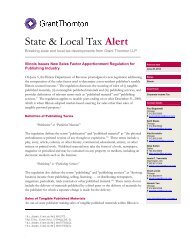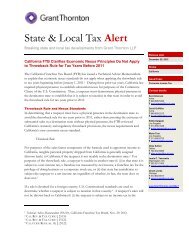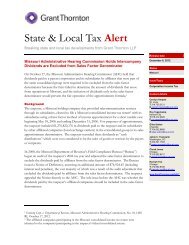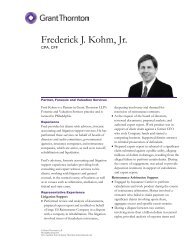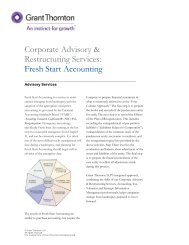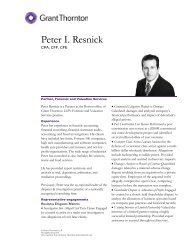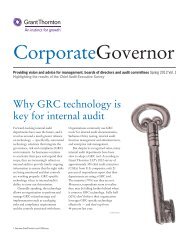The State of the Government Contractor Industry - Grant Thornton LLP
The State of the Government Contractor Industry - Grant Thornton LLP
The State of the Government Contractor Industry - Grant Thornton LLP
You also want an ePaper? Increase the reach of your titles
YUMPU automatically turns print PDFs into web optimized ePapers that Google loves.
<strong>The</strong> <strong>State</strong> <strong>of</strong> <strong>the</strong> <strong>Government</strong><br />
<strong>Contractor</strong> <strong>Industry</strong>: 2010<br />
White paper 2010
Contents<br />
01 2010 market outlook:<br />
Predicting <strong>the</strong> unpredictable<br />
05 A look at <strong>Grant</strong> <strong>Thornton</strong>’s<br />
15th Annual <strong>Government</strong><br />
<strong>Contractor</strong> <strong>Industry</strong> Survey
<strong>The</strong> <strong>State</strong> <strong>of</strong> <strong>the</strong> <strong>Government</strong> <strong>Contractor</strong> <strong>Industry</strong>: 2010<br />
2010 market outlook: Predicting <strong>the</strong><br />
unpredictable<br />
For many government contractors, business is booming – at<br />
least in comparison to <strong>the</strong> rest <strong>of</strong> <strong>the</strong> economy. Unlike most<br />
<strong>of</strong> <strong>the</strong> commercial sectors that suffered from major business<br />
disruption, financial losses and employee cutbacks in 2009, <strong>the</strong><br />
government contracting industry experienced steady growth,<br />
boasting a 12 percent increase over <strong>the</strong> preceding year. Although<br />
continued progress in <strong>the</strong> sector is expected over <strong>the</strong> next two<br />
years, <strong>the</strong> pace <strong>of</strong> growth will likely slow, as several potential<br />
challenges come to <strong>the</strong> forefront – including <strong>the</strong> difficult fiscal<br />
environment and insourcing. In addition, new compliance and<br />
ethics requirements issued by <strong>the</strong> Defense Contract Audit<br />
Agency (DCAA) and a variety <strong>of</strong> proposed policy changes will<br />
also continue to impact <strong>the</strong> market.<br />
Presumably, contractors will feel some <strong>of</strong> <strong>the</strong> effects <strong>of</strong> <strong>the</strong><br />
major budgetary constraints now being placed on <strong>the</strong>ir clients,<br />
with almost all agency budgets currently flat and expected<br />
to remain so for <strong>the</strong> foreseeable future. As a result, budget<br />
prioritization and strategic allocation <strong>of</strong> funds and resources<br />
will play an enhanced role in new project initiatives for most<br />
government bodies. In addition, program reviews are also taking<br />
precedence as departments consider what <strong>the</strong>y can live without<br />
and where <strong>the</strong>y can save money. Lastly, <strong>the</strong> appropriations<br />
process and its anticipated hurdles could have a fur<strong>the</strong>r numbing<br />
effect on agencies, restricting <strong>the</strong>ir ability to launch new<br />
initiatives pending <strong>the</strong> passage <strong>of</strong> a full, new appropriation.<br />
<strong>The</strong> fiscal picture<br />
With a tidal shift in <strong>the</strong> makeup <strong>of</strong> <strong>the</strong> federal budget, including<br />
an anticipated public debt <strong>of</strong> $20 trillion by 2019, significant<br />
changes inevitably loom on <strong>the</strong> horizon for government<br />
contractors and <strong>the</strong>ir clients. Fiscal pressures are becoming<br />
far more acute than in recent years, as mandatory spending<br />
continues to dominate <strong>the</strong> budget for most programs – including<br />
Medicaid, Medicare and Social Security – and with interest<br />
on debt growing dramatically as a portion <strong>of</strong> mandatory<br />
spending, rising from 11 percent today to 20 percent by 2019.<br />
Fur<strong>the</strong>rmore, as a proportion <strong>of</strong> <strong>the</strong> federal deficit, interest on<br />
debt will rise from 12 percent today to 85 percent by 2019. It<br />
goes without saying that such a deficit reversal poses an almost<br />
unprecedented fiscal challenge to <strong>the</strong> government and its<br />
departments – with <strong>the</strong> resolution <strong>of</strong> this challenge remaining far<br />
from clear.<br />
1
It is important to note that while most civilian agencies are<br />
slated for flat or reduced spending, in reality, <strong>the</strong> budgetary<br />
freeze only applies to about one third <strong>of</strong> <strong>the</strong> discretionary<br />
budget. For example, <strong>the</strong> proposed FY11 budget requests more<br />
money for national security than projected just six months<br />
ago, with <strong>the</strong> Department <strong>of</strong> Defense’s (DoD) base budget<br />
increasing 4.4 percent this year and 3 percent per year <strong>the</strong>reafter.<br />
Fur<strong>the</strong>rmore, DoD will receive $160 billion this year (and has<br />
requested <strong>the</strong> same amount next year) for overseas contingency<br />
operations. However, current projections show a decrease in<br />
contingency funding by two thirds as <strong>of</strong> FY12 – a target believed<br />
by many to be overly optimistic. Add to this <strong>the</strong> costs <strong>of</strong> base<br />
realignment and closure, as well as DoD health care ($45 billion<br />
a year and growing) and it becomes clear that despite its apparent<br />
budget stability, <strong>the</strong> DoD remains under enormous financial<br />
strain.<br />
Insourcing<br />
Insourcing has also become an important area <strong>of</strong> focus for<br />
government contractors in regard to business development and<br />
strategy, as well as employee retention. Currently, <strong>the</strong> DoD is<br />
leading <strong>the</strong> insourcing charge thanks in large part to <strong>the</strong> Secretary<br />
<strong>of</strong> Defense’s Workforce Initiative, which plans to hire 35,000<br />
new employees in FY10 and FY11. <strong>The</strong> goal <strong>of</strong> this initiative is<br />
to strategically build skill sets in-house while also reducing <strong>the</strong><br />
number <strong>of</strong> contracted positions used to perform <strong>the</strong>se critical<br />
functions to 26 percent <strong>of</strong> <strong>the</strong> workforce (from 39 percent in<br />
FY08). Nearly half <strong>of</strong> <strong>the</strong>se new positions are expected to be<br />
filled by contractors currently performing this work.<br />
Aggressive budgetary assumptions are tied to <strong>the</strong>se<br />
insourcing goals, with an expected $40,000 to $44,000 savings<br />
per insourced employee for approximately 17,000 to 22,000<br />
positions, raising significant questions—and attracting growing<br />
congressional interest—as to how this target was determined and<br />
whe<strong>the</strong>r it truly includes <strong>the</strong> total cost to <strong>the</strong> taxpayer. Fur<strong>the</strong>r,<br />
based on information from <strong>the</strong> DoD, <strong>the</strong> majority <strong>of</strong> positions<br />
already identified for insourcing are not within <strong>the</strong> realm <strong>of</strong><br />
critical skills targeted by <strong>the</strong> Secretary, but are fairly routine<br />
commercial mid- to lower-level positions, making <strong>the</strong> DoD’s<br />
analysis even more questionable.<br />
To <strong>the</strong>ir credit, civilian agencies have been more measured<br />
in <strong>the</strong>ir insourcing endeavors, better following <strong>the</strong> Office<br />
<strong>of</strong> Management and Budget’s guidance to take into account<br />
competition, cost/performance analyses and hierarchy <strong>of</strong><br />
workforce positions and needs in <strong>the</strong>ir insourcing reporting and<br />
implementation efforts. An example <strong>of</strong> this is <strong>the</strong> Department<br />
<strong>of</strong> Homeland Security, which is currently undergoing efficiency<br />
reviews across <strong>the</strong> board and focusing on internal skills that are<br />
needed in order to develop a management core. In addition, <strong>the</strong><br />
<strong>State</strong>/USAID is increasing its focus on workforce development,<br />
while <strong>the</strong> Department <strong>of</strong> Health and Human Services is<br />
developing a component-level insourcing plan.<br />
As to be expected, with <strong>the</strong> expansion <strong>of</strong> insourcing has also<br />
come increased public scrutiny as to <strong>the</strong> recruitment process <strong>of</strong><br />
<strong>the</strong>se new employees, as varying parties begin to examine <strong>the</strong><br />
integrity <strong>of</strong> business relationships and role <strong>of</strong> “merit system”<br />
hiring in this process. Unfortunately, employee poaching by <strong>the</strong><br />
government for insourced positions has <strong>the</strong> potential to make<br />
a huge impact on <strong>the</strong> smaller services firms, raising discussions<br />
around <strong>the</strong> development <strong>of</strong> a mutual, non-compete hiring<br />
initiative.<br />
Compliance and ethics programs<br />
Beginning with <strong>the</strong> War on Terror and Hurricane Katrina,<br />
<strong>the</strong> government procurement process as <strong>of</strong> late has undergone<br />
significant scrutiny, resulting in several new guidelines for<br />
government contractors in <strong>the</strong>ir compliance and ethics programs.<br />
Spearheaded by <strong>the</strong> Federal Acquisition Regulation (FAR)<br />
Council, <strong>the</strong>se requirements first became effective in December<br />
2007 through <strong>the</strong> <strong>Contractor</strong> Code <strong>of</strong> Business Ethics and<br />
Conduct clause at FAR 52.203-13 and are applicable to all<br />
contracts <strong>of</strong> $5 million or more with a performance period <strong>of</strong><br />
120 days or more. Under <strong>the</strong>se new compliance regulations,<br />
government contractors are required to have <strong>the</strong> following in<br />
place:<br />
1. A code <strong>of</strong> business ethics and conduct within 30 days <strong>of</strong><br />
contract award, making <strong>the</strong> code available to each employee<br />
engaged in performance <strong>of</strong> <strong>the</strong> contract.<br />
2. A business ethics awareness program and internal control<br />
system within 90 days <strong>of</strong> contract award. This requirement<br />
does not apply to small business companies and contracts for<br />
<strong>the</strong> acquisition <strong>of</strong> a commercial item.<br />
3. Reasonable steps for communicating <strong>the</strong> contractor’s<br />
standards and procedures and o<strong>the</strong>r aspects <strong>of</strong> <strong>the</strong><br />
contractor’s business ethics and awareness and compliance<br />
program and internal control system, conducting effective<br />
training programs and also disseminating information<br />
appropriate to an individual’s respective roles and<br />
responsibilities.<br />
This new clause also requires that government contractors<br />
now establish standards and procedures to facilitate timely<br />
discovery <strong>of</strong> improper conduct in connection with government<br />
contracts, as well as ensure that corrective measures are promptly<br />
instituted and carried out should a problem exist. With this in<br />
mind, <strong>the</strong> <strong>Contractor</strong> Code <strong>of</strong> Business Ethics and Conduct<br />
clause at FAR 52.203-13 includes seven minimum standards that<br />
<strong>the</strong> contractor’s internal control system must meet:<br />
1. Assign responsibility at a sufficiently high level and with<br />
adequate resources to assure effectiveness <strong>of</strong> <strong>the</strong> business<br />
ethics awareness and compliance program and internal<br />
control system.<br />
2
2. Reasonable efforts not to include an individual as a principal<br />
who has engaged in conduct in conflict with <strong>the</strong> company’s<br />
code <strong>of</strong> business ethics and conduct.<br />
3. Periodic reviews <strong>of</strong> company business practices, procedures,<br />
policies and internal controls for compliance with <strong>the</strong><br />
contractor’s code <strong>of</strong> business ethics and conduct.<br />
4. An internal reporting mechanism, such as a hotline, which<br />
allows for anonymity or confidentiality, by which employees<br />
may report suspected instances <strong>of</strong> improper conduct.<br />
5. Disciplinary action for improper conduct or for failing to<br />
take reasonable steps to prevent or detect improper conduct.<br />
6. Timely disclosure in writing to <strong>the</strong> Office <strong>of</strong> Inspector<br />
General and <strong>the</strong> Contracting Officer whenever <strong>the</strong> company<br />
has credible evidence that a principal, employee, agent or<br />
subcontractor has violated Federal law involving fraud,<br />
conflict <strong>of</strong> interest, bribery, gratuities or <strong>the</strong> False Claims Act.<br />
7. Full cooperation with any government agencies responsible<br />
for audits, investigations or corrective actions.<br />
<strong>The</strong>se new regulations place considerable risks on<br />
government contractors, particularly in regard to <strong>the</strong>ir internal<br />
control systems, not only requiring internal or external audits<br />
<strong>of</strong> <strong>the</strong> compliance system, but also requiring <strong>the</strong> company to<br />
make formal disclosure to <strong>the</strong> government whenever <strong>the</strong>re is<br />
credible evidence that a violation has occurred. As a result, it is<br />
imperative for government contractors that all audits required<br />
for <strong>the</strong> internal control system are performed by auditors with<br />
expert knowledge <strong>of</strong> federal procurement rules and regulations.<br />
Fur<strong>the</strong>rmore, all internal or external audits <strong>of</strong> <strong>the</strong> compliance<br />
system should include sufficient audit steps to identify <strong>the</strong> cause<br />
<strong>of</strong> <strong>the</strong> perceived compliance issue and appropriate remedies.<br />
New developments at <strong>the</strong> DCAA<br />
Regrettably, many <strong>of</strong> <strong>the</strong> issues that fueled <strong>the</strong> creation <strong>of</strong><br />
<strong>the</strong>se new compliance standards resulted from audit reports<br />
<strong>of</strong> <strong>the</strong> DCAA that ei<strong>the</strong>r mischaracterized <strong>the</strong> facts or were<br />
misinterpreted by parties attempting to politicize routine<br />
government contracting issues. Consequently, <strong>the</strong> DCAA<br />
finds itself <strong>the</strong> subject <strong>of</strong> increased political scrutiny and is now<br />
implementing changes in its approach to audits.<br />
<strong>The</strong> DCAA’s troubles began on July 22, 2008, when <strong>the</strong><br />
<strong>Government</strong> Accountability Office (GAO) issued a report to<br />
Congress concluding that, after reviewing certain audit files,<br />
<strong>the</strong> DCAA had failed to comply with <strong>the</strong> Generally Accepted<br />
<strong>Government</strong> Audit Standards, including:<br />
1. Documentation in <strong>the</strong> work paper files did not support <strong>the</strong><br />
audit opinion.<br />
2. DCAA supervisors dropped findings and changed audit<br />
opinions without adequate evidence for <strong>the</strong> changes.<br />
3. Sufficient work was not performed to support <strong>the</strong> audit<br />
opinions.<br />
<strong>The</strong> GAO also stated that, in <strong>the</strong>ir opinion, <strong>the</strong> DCAA was<br />
too lenient on contractors and questioned whe<strong>the</strong>r <strong>the</strong> DCAA<br />
had sufficient independence from <strong>the</strong> contractors <strong>the</strong>y were<br />
auditing. <strong>The</strong> GAO concluded that <strong>the</strong> DCAA’s failures were<br />
<strong>the</strong> result <strong>of</strong> a management and agency culture that focused on<br />
a production-oriented mission and paid inadequate attention to<br />
performing quality audits.<br />
3
In response to <strong>the</strong> GAO’s report, <strong>the</strong> DCAA issued a flurry<br />
<strong>of</strong> new policies and procedures, which included <strong>the</strong> following:<br />
1. Significant deficiencies/material weaknesses and audit<br />
opinions on internal control systems: <strong>The</strong> DCAA would<br />
no longer issue reports stating that systems are inadequate<br />
in part, with <strong>the</strong> new policy being that if any significant<br />
deficiency or material weakness was noted, <strong>the</strong> report would<br />
include <strong>the</strong> opinion that <strong>the</strong> system is inadequate. <strong>The</strong><br />
new guidance also stated that <strong>the</strong> DCAA would no longer<br />
include recommendations to improve <strong>the</strong> system in <strong>the</strong><br />
audit report and that it was not necessary to demonstrate<br />
actual questioned costs to report a significant deficiency/<br />
material weakness, but ra<strong>the</strong>r only that <strong>the</strong>re is a possibility<br />
<strong>of</strong> questioned costs.<br />
2. Reporting suspected contractor fraud and o<strong>the</strong>r<br />
contractor irregularities: <strong>The</strong> working level auditor<br />
is authorized to make <strong>the</strong> fraud referral directly to <strong>the</strong><br />
cognizant investigators without prior discussion with<br />
or approval by <strong>the</strong> DCAA Branch Manager or Resident<br />
Auditor.<br />
3. Reporting significant/sensitive unsatisfactory conditions<br />
related to actions <strong>of</strong> government <strong>of</strong>ficials: <strong>The</strong> DCAA is<br />
authorized to report a Contracting Officer directly to <strong>the</strong><br />
Inspector General when a Contracting Officer ignores an<br />
audit recommendation and negotiates costs or pr<strong>of</strong>it that <strong>the</strong><br />
DCAA considers unreasonable and excessive.<br />
4. Audits <strong>of</strong> <strong>the</strong> contractor code <strong>of</strong> business ethics and<br />
conduct: Auditors must perform procedures to address<br />
<strong>the</strong> requirements <strong>of</strong> <strong>the</strong> new compliance regulations during<br />
audits <strong>of</strong> a contractor’s control environment and accounting<br />
system controls. <strong>The</strong> audit program requires that <strong>the</strong> DCAA<br />
obtain and review copies <strong>of</strong> <strong>the</strong> contractor’s internal/external<br />
audit reports performed as part <strong>of</strong> <strong>the</strong> internal control<br />
system.<br />
<strong>The</strong> road ahead<br />
For government contractors, <strong>the</strong>se changes are just <strong>the</strong><br />
beginning, with several additional procurement policies set to<br />
make <strong>the</strong>ir debut very soon, including regulations regarding<br />
personal conflicts <strong>of</strong> interests, new definitions for inherently<br />
governmental, closely associated and critical positions, and <strong>the</strong><br />
Defense Federal Acquisition Regulation’s proposed standard<br />
that if a contractor fails a systems audit, for even <strong>the</strong> most minor<br />
<strong>of</strong> reasons, <strong>the</strong> DoD will withhold a percentage <strong>of</strong> its payments<br />
until <strong>the</strong> problem is rectified.<br />
Needless to say, <strong>the</strong> government contracting industry is<br />
clearly in a state <strong>of</strong> change and uncertainly – posing potential<br />
risks, as well as opportunities – to those businesses operating<br />
in this arena. Companies seeking to secure <strong>the</strong>ir place in this<br />
competitive marketplace must take heed, thinking strategically<br />
and acting proactively to ultimately ensure that <strong>the</strong>y are<br />
operating as efficiently and effectively as possible.<br />
As a follow-up to its initial findings, <strong>the</strong> GAO issued<br />
a highly-critical report on Sept. 23, 2009, summarizing its<br />
examination <strong>of</strong> several DCAA <strong>of</strong>fices and concluding that major<br />
problems existed throughout <strong>the</strong> DCAA. Shortly <strong>the</strong>reafter,<br />
<strong>the</strong> DCAA Director was terminated and transferred to ano<strong>the</strong>r<br />
position within <strong>the</strong> DoD.<br />
4
<strong>The</strong> <strong>State</strong> <strong>of</strong> <strong>the</strong> <strong>Government</strong> <strong>Contractor</strong> <strong>Industry</strong>: 2010<br />
A look at <strong>Grant</strong> <strong>Thornton</strong>’s 15th<br />
Annual <strong>Government</strong> <strong>Contractor</strong><br />
<strong>Industry</strong> Survey<br />
<strong>The</strong> <strong>Grant</strong> <strong>Thornton</strong> 15th Annual <strong>Government</strong> <strong>Contractor</strong><br />
<strong>Industry</strong> Survey provides perspective on how <strong>the</strong> government<br />
contracting industry has evolved over <strong>the</strong> past year, through<br />
<strong>the</strong> collection and analysis <strong>of</strong> responses from a cross section<br />
<strong>of</strong> small, medium and large companies that consider <strong>the</strong><br />
federal government to be a significant customer. Providing a<br />
comprehensive view <strong>of</strong> <strong>the</strong> industry as a whole, <strong>the</strong> survey aims<br />
to provide benchmarking data and identify key trends regarding<br />
<strong>the</strong> day-to-day business operations, as well as <strong>the</strong> future<br />
challenges and opportunities facing government contractors.<br />
Revenue trend from federal contracts<br />
While much <strong>of</strong> <strong>the</strong> commercial business sector deteriorated in<br />
2009, <strong>the</strong> government contracting industry remained strong,<br />
with 50 percent <strong>of</strong> respondents reporting increased revenue from<br />
federal government contracts, 30 percent reporting no significant<br />
change in revenue and only 20 percent experiencing reduced<br />
revenue – a trend in keeping with <strong>the</strong> past four surveys.<br />
Revenue trend from federal business<br />
Increased 50%<br />
Decreased 20%<br />
No change 30%<br />
Revenue from cost reimbursable contracts<br />
<strong>The</strong> government’s shift in direction from efficient, commercial<br />
practices to a more micromanaged, audit and investigation<br />
environment is evidenced by survey responses regarding revenue<br />
by contract type. According to respondents, 46 percent <strong>of</strong><br />
<strong>the</strong>ir revenue was from cost reimbursable work, continuing<br />
an upward trend noted in recent years’ surveys. <strong>The</strong> jump in<br />
cost reimbursable contracts was first noted in <strong>the</strong> 12th Annual<br />
Survey when it jumped to 39 percent – up 11 percent from <strong>the</strong><br />
year before. In <strong>the</strong> ensuing three years, <strong>the</strong> percentage <strong>of</strong> revenue<br />
from cost reimbursable contracts continued to rise to 46 percent<br />
in this year’s survey.<br />
It is impossible to equate <strong>the</strong> high use <strong>of</strong> cost reimbursable<br />
contracts with <strong>the</strong> notion that <strong>the</strong> government is attempting<br />
to use more commercial processes to streamline federal<br />
procurement, as time and material contracting is <strong>the</strong> primary<br />
method used in <strong>the</strong> commercial business sector to acquire<br />
pr<strong>of</strong>essional services.<br />
Management and support headcount as a percentage <strong>of</strong><br />
total headcount<br />
For government contractors, <strong>the</strong> percentage <strong>of</strong> management and<br />
support No change staff to total headcount is typically a key component <strong>of</strong><br />
price competitiveness. This year’s survey shows that, on average,<br />
Decreased<br />
management and support functions comprise 14.6 percent <strong>of</strong><br />
total Increased headcount. This is a modest decrease from <strong>the</strong> 16 percent<br />
shown in last year’s survey and a slight increase from <strong>the</strong> 13.8<br />
percent shown two years ago.<br />
5
Pr<strong>of</strong>it rate (before interest and taxes) as a percentage <strong>of</strong><br />
revenue<br />
One common misconception regarding <strong>the</strong> government<br />
contracting industry is that it is a high-pr<strong>of</strong>it business.<br />
Unfortunately, this notion could not be fur<strong>the</strong>r from <strong>the</strong> truth.<br />
Surveyed companies provided financial information on gross<br />
pr<strong>of</strong>it before interest and taxes as a percentage <strong>of</strong> gross revenue,<br />
with 45 percent showing ei<strong>the</strong>r no pr<strong>of</strong>it or pr<strong>of</strong>it rates between<br />
1 and 5 percent compared to 37 percent in last year’s survey. In<br />
addition, 85 percent had ei<strong>the</strong>r no pr<strong>of</strong>it or pr<strong>of</strong>it rates between<br />
1 and 10 percent compared to 76 percent in last year’s survey.<br />
<strong>The</strong> number <strong>of</strong> surveyed companies with pr<strong>of</strong>it rates above 10<br />
percent shrank from 24 percent last year to 15 percent this year.<br />
Pr<strong>of</strong>it rate before interest and taxes<br />
15 th<br />
Annual Survey<br />
Annual Survey<br />
1 -- 5% pr<strong>of</strong>it rate<br />
6 -- 10% pr<strong>of</strong>it rate<br />
11 -- 15% pr<strong>of</strong>it rate<br />
>15% pr<strong>of</strong>it rate<br />
No pr<strong>of</strong>it<br />
31%<br />
32%<br />
40%<br />
39%<br />
12%<br />
10%<br />
3%<br />
14%<br />
14%<br />
5%<br />
14 th 44%<br />
Procedures for identifying out-<strong>of</strong>-scope work<br />
Out-<strong>of</strong>-scope work can come from ei<strong>the</strong>r directed or<br />
constructive changes, both <strong>of</strong> which entitle <strong>the</strong> contractor<br />
to an equitable adjustment in contract price and schedule. In<br />
general, directed changes are easy to identify as <strong>the</strong>y arise from<br />
government issued contract modifications and, in such cases,<br />
<strong>the</strong>re is no argument whe<strong>the</strong>r <strong>the</strong> contract has been altered.<br />
Constructive changes, on <strong>the</strong> o<strong>the</strong>r hand, are more difficult to<br />
determine, as <strong>the</strong>y can only be identified by a contractor that has<br />
effective procedures in place to monitor contract performance<br />
against <strong>the</strong> contract statement <strong>of</strong> work.<br />
Often, equitable adjustment requests for constructive<br />
changes have been resisted by <strong>the</strong> government arguing that<br />
<strong>the</strong> contract has not changed. However, based on <strong>the</strong> survey<br />
responses received, it appears that many respondents have<br />
improved <strong>the</strong>ir procedures for identifying out-<strong>of</strong>-scope work,<br />
with 44 percent identifying <strong>the</strong>ir procedures as very effective and<br />
39 percent calling <strong>the</strong>ir procedures somewhat effective. <strong>The</strong>se<br />
findings are an improvement from last year’s survey.<br />
Effectiveness at identifying out-<strong>of</strong>-scope work<br />
15 th<br />
14 th<br />
Annual Survey<br />
Annual Survey<br />
Very effective<br />
Somewhat effective<br />
Not effective<br />
35%<br />
39%<br />
45%<br />
17%<br />
20%<br />
6
<strong>Government</strong> requests for out-<strong>of</strong>-scope work without contract<br />
modification<br />
Surveyed companies were also asked to provide <strong>the</strong> frequency<br />
<strong>of</strong> government requests for out-<strong>of</strong>-scope work without<br />
contract modification, with 78 percent stating that government<br />
customers frequently or occasionally ask for out-<strong>of</strong>-scope work<br />
without providing a contract modification. This information<br />
is troubling, as government regulations are very clear that only<br />
<strong>the</strong> Contracting Officer has <strong>the</strong> authority to change <strong>the</strong> contract<br />
and such changes should occur through contract modification or<br />
o<strong>the</strong>r formal authorization.<br />
Fur<strong>the</strong>rmore, surveyed companies were also asked to provide<br />
<strong>the</strong> response <strong>the</strong>y typically provide when <strong>the</strong> government<br />
requests out-<strong>of</strong>-scope work without issuing a contract<br />
modification, with 81 percent ei<strong>the</strong>r always performing <strong>the</strong><br />
work or sometimes performing <strong>the</strong> work. It is clear from <strong>the</strong>se<br />
findings that <strong>the</strong> necessity to please <strong>the</strong> customer is a prime<br />
requirement for keeping contracts, and that certain government<br />
<strong>of</strong>ficials are taking full advantage <strong>of</strong> this fact despite government<br />
procurement regulations.<br />
Labor multipliers<br />
Used as a means <strong>of</strong> pricing work, a labor multiplier is derived<br />
by dividing <strong>the</strong> total loaded labor price by <strong>the</strong> bare cost <strong>of</strong><br />
labor. For example, assume a direct labor employee is paid $10<br />
per hour. Fur<strong>the</strong>r, assume that after applying fringe benefits,<br />
overhead, G&A and fee, <strong>the</strong> $10 in labor is marked up to $23.<br />
<strong>The</strong> labor multiplier would <strong>the</strong>n be 2.3 ($23/$10). <strong>The</strong> labor<br />
multipliers in this year’s survey are somewhat lower than last<br />
year, with <strong>the</strong> multiplier for on-site direct labor falling from 2.4<br />
to 2.1 and for <strong>of</strong>f-site labor from 2.0 to 1.8 – possibly resulting<br />
from an increase in competition in <strong>the</strong> marketplace.<br />
<strong>Government</strong> requests for out-<strong>of</strong>-scope work without<br />
contract modification<br />
Frequently 16%<br />
Occasionally 62%<br />
Never 22%<br />
Response to government requests for out-<strong>of</strong>-scope work<br />
without contract modification<br />
Always perform 15%<br />
Refuse to perform 19%<br />
Sometimes perform/refuse 66%<br />
Average labor multiplier through fee<br />
15 th Annual 14 th Annual<br />
Labor type Survey Multiplier Survey Multiplier<br />
On-site direct labor 2 . 1 2 . 4<br />
Off-site direct labor 1.8 2.0<br />
7
<strong>Grant</strong> <strong>Thornton</strong> has been helping<br />
government contractors develop<br />
<strong>the</strong>ir business for more than 25 years.<br />
We have a proven track record in<br />
helping our clients face <strong>the</strong> ever<br />
increasing challenges <strong>of</strong> operating in<br />
<strong>the</strong> government contracting industry.<br />
Passion for serving our clients, technical expertise, and partner<br />
involvement have been <strong>the</strong> hallmark <strong>of</strong> <strong>Grant</strong> <strong>Thornton</strong> <strong>LLP</strong> in<br />
<strong>the</strong> U.S. for more than 80 years. Plus, you get <strong>the</strong> benefit <strong>of</strong><br />
<strong>Grant</strong> <strong>Thornton</strong> International member firms in more than<br />
100 countries around <strong>the</strong> world. Give Kerry Hall, <strong>Government</strong><br />
<strong>Contractor</strong> <strong>Industry</strong> Practice Leader, a call at 703.847.7515 or visit<br />
www.<strong>Grant</strong><strong>Thornton</strong>.com/govcon to learn more about<br />
our industry services.<br />
Find out how it feels to work with people who love what <strong>the</strong>y do!<br />
Audit • Tax • Advisory
Fur<strong>the</strong>r information<br />
Contacts<br />
About this white paper<br />
This white paper summarizes discussions held at<br />
<strong>the</strong> <strong>Grant</strong> <strong>Thornton</strong> <strong>LLP</strong> <strong>Government</strong> <strong>Contractor</strong><br />
Roundtable on Tuesday, March 9, 2010. Audience<br />
members included chief executive <strong>of</strong>ficers, chief<br />
financial <strong>of</strong>ficers and o<strong>the</strong>r key decision-makers<br />
with government contracting firms. Stan Soloway,<br />
President and Chief Executive Officer <strong>of</strong> <strong>the</strong><br />
Pr<strong>of</strong>essional Services Council, and Norm Duquette,<br />
<strong>Grant</strong> <strong>Thornton</strong> <strong>LLP</strong> <strong>Government</strong> <strong>Contractor</strong><br />
Specialist, discussed major issues facing <strong>the</strong><br />
government contracting marketplace, as well as <strong>the</strong><br />
results <strong>of</strong> <strong>the</strong> 15th Annual <strong>Government</strong> <strong>Contractor</strong><br />
<strong>Industry</strong> Survey.<br />
National Office<br />
175 West Jackson Boulevard<br />
Chicago, IL 60604<br />
312.856.0200<br />
National Tax Office<br />
1900 M Street, NW, Suite 300<br />
Washington, DC 20036<br />
202.296.7800<br />
Arizona<br />
Phoenix 602.474.3400<br />
California<br />
Irvine 949.553.1600<br />
Los Angeles 213.627.1717<br />
Sacramento 916.449.3991<br />
San Diego 858.704.8000<br />
San Francisco 415.986.3900<br />
San Jose 408.275.9000<br />
Woodland Hills 818.936.5100<br />
Kansas<br />
Wichita 316.265.3231<br />
Maryland<br />
Baltimore 410.685.4000<br />
Massachusetts<br />
Boston 617.723.7900<br />
Michigan<br />
Detroit 248.262.1950<br />
Minnesota<br />
Minneapolis 612.332.0001<br />
Missouri<br />
Kansas City 816.412.2400<br />
St. Louis 314.735.2200<br />
Nevada<br />
Reno 775.786.1520<br />
Oklahoma<br />
Oklahoma City 405.218.2800<br />
Tulsa 918.877.0800<br />
Oregon<br />
Portland 503.222.3562<br />
Pennsylvania<br />
Philadelphia 215.561.4200<br />
South Carolina<br />
Columbia 803.231.3100<br />
Texas<br />
Austin 512.391.6821<br />
Dallas 214.561.2300<br />
Houston 832.476.3600<br />
San Antonio 210.881.1800<br />
Utah<br />
Salt Lake City 801.415.1000<br />
Colorado<br />
Denver 303.813.4000<br />
Florida<br />
Fort Lauderdale 954.768.9900<br />
Miami 305.341.8040<br />
Orlando 407.481.5100<br />
Tampa 813.229.7201<br />
Georgia<br />
Atlanta 404.330.2000<br />
Hawaii<br />
Honolulu 808.536.0066<br />
Illinois<br />
Chicago 312.856.0200<br />
Oakbrook Terrace 630.873.2500<br />
New Jersey<br />
Edison 732.516.5500<br />
New Mexico<br />
Albuquerque 505.855.7900<br />
New York<br />
Long Island 631.249.6001<br />
Downtown 212.422.1000<br />
Midtown 212.599.0100<br />
North Carolina<br />
Charlotte 704.632.3500<br />
Greensboro 336.271.3900<br />
Raleigh 919.881.2700<br />
Ohio<br />
Cincinnati 513.762.5000<br />
Cleveland 216.771.1400<br />
Virginia<br />
Alexandria 703.837.4400<br />
McLean 703.847.7500<br />
Washington<br />
Seattle 206.623.1121<br />
Washington, D.C.<br />
Washington, D.C. 202.296.7800<br />
Wisconsin<br />
Appleton 920.968.6700<br />
Madison 608.257.6761<br />
Milwaukee 414.289.8200<br />
Disclaimer: <strong>The</strong> views and opinions expressed in this white paper are those <strong>of</strong> each individual speaker and do not necessarily reflect <strong>the</strong> <strong>of</strong>ficial policies and positions <strong>of</strong><br />
<strong>Grant</strong> <strong>Thornton</strong> <strong>LLP</strong> or <strong>the</strong> Pr<strong>of</strong>essional Services Council, nor do <strong>the</strong>se opinions necessarily reflect those <strong>of</strong> <strong>the</strong> o<strong>the</strong>r speaker.
© <strong>Grant</strong> <strong>Thornton</strong> <strong>LLP</strong><br />
All rights reserved<br />
U.S. member firm <strong>of</strong> <strong>Grant</strong> <strong>Thornton</strong> International Ltd




